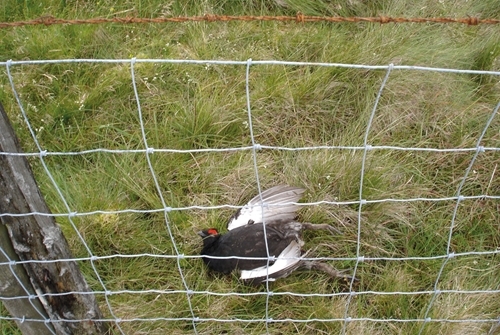The problem
Local reports show that black grouse collisions with some stock fences can be frequent. During limited one-off searches during the winter of 2000/01, we found 1.4 carcasses per kilometre. Bird collisions with fences are widely documented. Two quantified studies in the Scottish Highlands have reported average collision rates for black grouse on deer fences of 0.4 and 0.6 per kilometre per year and identified such a rate as potentially damaging the population. The reports from the North Pennines, including those above, do not quantify any collision rate but do indicate they can be within a similar order of magnitude as for Highland deer fences.
Strict quantification of collision rates and their impact on black grouse populations in the North Pennines would be time-consuming and expensive, but there appears to be certain conditions where stock fences pose a particularly severe problem for black grouse. These include exposed positions, especially convex breaks of slope, proximity to lek sites (the birds’ display arenas) and also to favoured feeding areas. Fencing is frequently advocated or necessary to control grazing for conservation purposes. This can include enhancing ground vegetation and also planting trees for black grouse.

Black grouse collisions with some stock fences can be frequent.
Collisions with fencing could mitigate such otherwise positive actions and, in extreme cases, outweigh them. We recommend marking stock fences, particularly the top wire to make them more visible to flying birds. Several options for marking exist, including coloured barrier netting, reflective metal plates and bundles of heather. Coloured netting is widely considered unacceptable in open landscapes and attaching bundles of heather can be time consuming. Although not proven, the fixing of metal plates is reported to be effective at reducing collisions by red grouse.
Recommendations
- Seek advice on the siting of new fences within the occupied range of black grouse from the GWCT.
- All identified problem stretches of fencing should be removed if possible.
- To maximise visibility to flying birds, the top wire should be marked at least once between each upright post with reflective metal plates or bundles of heather.
- All new grant-aided fences (for grazing management and tree planting) within areas occupied by black grouse should incorporate the costs of marking.
- Relevant agencies should consider making grants available for repositioning, marking and lowering top wires on existing problem fences.